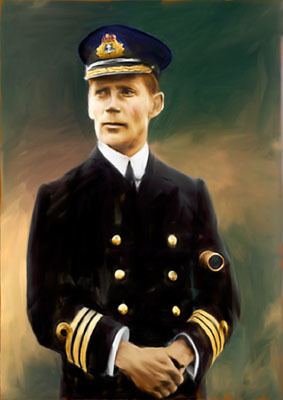Years of service 1889–1934 | Name Walter Hose Rank Rear admiral | |
 | ||
Commands held Chief of the Naval StaffHMCS Rainbow Battles/wars Boxer RebellionFirst World WarU-boat Campaign Battles and wars Boxer Rebellion, U-boat Campaign, World War I | ||
Rear Admiral Walter Hose (2 October 1875 – 22 June 1965) was an officer in the Royal Canadian Navy. He was the founder of the Royal Canadian Naval Volunteer Reserve. Along with Charles Kingsmill, Walter Hose is known as the "Father of the Royal Canadian Navy".
Contents

Early career with the Royal Navy
Hose was born on a ship in the Indian Ocean and joined the Royal Navy when he was 14. He was assigned to HMS Britannia upon entering the service. As he rose through the ranks he held six commands including commanding gunboats in Asia and a torpedo gunboat with the Home Fleet. He reached his pinnacle appointment in the Royal Navy as executive officer aboard HMS Cochrane in 1909; however finding advancement too slow he looked into joining the infant Canadian navy.
HMCS Rainbow and the First World War
Originally on loan from the Royal Navy, Hose resigned his commission and formally transferred to the Royal Canadian Navy in 1912. Upon his arrival he commanded HMCS Rainbow out of the naval base at Esquimalt. Due to the lack of Royal Navy ships along the northwest Pacific coast, Hose and the Rainbow were ordered to protect shipping from German raiders including the cruisers Leipzig and Nürnberg. After the threat had passed, Commander Hose spent the next while preventing German vessels from leaving port and even taking two prizes. He was then named Captain of Patrols by Admiral Charles Kingsmill. As captain of patrols he commanded over fifty vessels to fight the U-boat threat. It was the position he would hold until the end of the war.
Interwar service
After the retirement of Admiral Kingsmill, Hose was appointed acting Director of the Naval Service in 1921 and Director of the Naval Service in 1922. During his time as commander Hose decommissioned the majority of the navy, and shut the Royal Naval College of Canada and the Youth Training Establishment in Halifax. He took the money saved by doing this and formally created the Royal Canadian Naval Volunteer Reserve.
In 1922 government cuts in the armed services of Canada were put in place and there was an effort by the government of the day to integrate the services under one commander-in-chief. Hose argued against this, demanding to continue to have access to the minister. Aided by the deputy minister Georges Desbarats, he prevented the navy from falling under the command of the position of the Chief of Staff. The position of Director was renamed as Chief of the Naval Staff in 1928 and he served in this position until his retirement in 1934.
Hose died in Windsor, Ontario in 1965 and received a full military funeral. A monument at Point Pleasant Park in Halifax honours his work saving and building the Royal Canadian Navy during the difficult years after the First World War and in the Great Depression.
